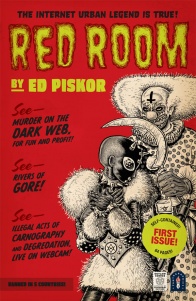Ed Piskor is one of the most accomplished cartoonists working today. Whether you know him from “Hip Hop Family Tree,” “X-Men: Grand Design,” or “Wizzywig,” Piskor is sure to surprise you with “Red Room,” his new monthly series from Fantagraphics. Be warned that spoilers follow.
Written and illustrated by Ed PiskorCover by Ed PiskorAided by the anonymous dark web and nearly untraceable cryptocurrency, a criminal subculture has emerged. It livestreams murders as entertainment. Who are the killers? Who are the victims? Who is paying to watch? How to stop it? Red Room is constructed as a series of interconnected stories, shining a light on the characters who exist in the ugliest of corners in cyberspace. Piskor cuts the graphic horror with his sharp sense of humor, gorgeous cartooning, and dynamic storytelling. Red Room peels back the curtain on the side of humanity few of us knew existed, let alone understood. Fans and followers of Piskor’s YouTube channel sensation, Cartoonist Kayfabe, have already made Red Room: The Antisocial Network one of the most eagerly anticipated and talked-about releases of 2021.
Piskor establishes a lot about “Red Room” in its first few pages, even before getting to the main plot. The world of this book is one that is not entirely dissimilar to ours, but Piskor illustrates it as a little less friendly and a little grosser. Piskor conjures up some serious R. Crumb vibes in the way that he illustrates Davis Fairchild, with every negative feature exaggerated. Davis has sweat-stains on his shirt, a gut that hangs out over his belt, and jowls drooping off his face. He’s drawn with lots of disgusting detail, and yet, Piskor draws him sympathetically.
This makes the reveal of his true nature even more shocking.
Piskor has compared “Red Room” to old EC Comics stories, and there is definitely some connective tissue here, specifically in the ‘twist’ that was ever-present in EC tales. Davis is portrayed as a grieving husband and father, a hard worker who is abused at work, and a guy without much going on for him. All of this is buttressed against the images of the Red Rooms, which are basically cam-girl rooms, but instead of sex workers, the viewer is watching people be tortured and murdered. Because of the way that Piskor presents things, it is a little unclear how they will connect initially. Did Davis’s wife and daughter not get killed, but rather fed into the Red Room system?
When Piskor reveals that, no, Davis is a Red Room performer, there is a desire on the part of the reader to still feel sympathy for him. Did he turn to this because of his grief? Did years of abuse lead him to this? Piskor doesn’t give any clear answers, but it seems like his nature is truly evil, and this isn’t necessarily a reaction to anything other than Davis being true to himself. Sure, Davis uses the grief as an excuse, but people die all the time, and their families don’t become monsters. But even presenting that possibility gives Davis more depth than you’d expect from such a story.
The plot, the very idea of Red Rooms, is an incredibly modern idea. This is a story that could’ve only been told in the very recent past, and using Bitcoin as the currency for tips further sets it in the modern day. Stories like this can sometimes feel dated quickly due to the emphasis on cutting edge technology and ideas. But “Red Room” doesn’t present the Red Rooms as a brand new concept, so the “hey, look at this Discman, the first portable CD player!” dated nature is not there.
The violence in the book is extreme, but is mostly cartoonish and somewhat silly. While it may be gross to have someone’s tongue pulled through an eye socket, it’s also absurd. It never gets so silly that the Red Rooms lose their intensity or so over the top that the violence loses its visceral edge, but it also doesn’t turn into simply torture porn, even though my definition, this is exactly torture porn.
This book is an anthology, and so we will likely not see too much more of Davis, but we are introduced to a few elements, like the underground video store, or the daughter’s friend who is into watching mutilation videos, that seems like they will show up again in the future. Taylor, Brianna Fairchild’s friend, seems like a perfect character to build a future installment around, and I’m sure that we’ll see the Decimator show up in future Red Room viewings. I’m interested to see just how interconnected the issues are, because while the Red Room concept in general has a lot of potential stories, without an overarching plot, the issues may not have as much emotional impact.
However, if the individual issues can have as much nuance, detail, and creativity as the first one, the series will be a fun, intense, and disturbing read. While it seems like Piskor’s work can scrimp on the emotions at times, his skill as a draftsman and storyteller more than makes up for it.
Final Verdict: 7.8 – A haunting, violent, and over the top portrait of modern society.




